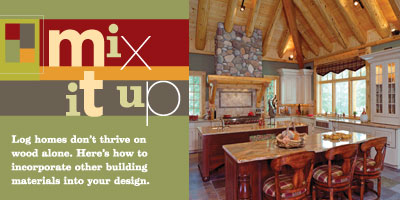 Log home enthusiasts may not like to admit it, but there really is such a thing as overdoing it. Sure, we love our logs, but being surrounded by log walls, mantels, clocks, picture frames—you get the idea—can overwhelm even the most passionate wood devotee. "If a client wants all wood in his home, we'll try to point out that you can end up with too much wood," explains Denny Nelson of Bridger Mountain Log Homes in Belgrade, Montana. "By utilizing drywall, stone and other materials, you can break up the continuity of wood and actually accentuate the natural beauty of your logs." Don't worry: Incorporating other building materials into your home's design doesn't mean you have to sacrifice that log home look you long for. You can still put logs wherever you want, but by mixing it up a bit, we think you'll find that sometimes less really is more. Material World Mixing materials may not be a new concept, but in recent years, it has become quite the hot trend. "Incorporating other materials allows you to create a richer texture, adding more architectural interest to your home," explains Kyle Tage, AIA, of Locati Architects in Bozeman, Montana. "You can still have that quintessential log home feel, but with the added benefit and extra dose of personality that comes when you use a variety of materials." Kyle adds that the increasing desire to add other materials doesn't imply that people are losing interest in logs, they're just being smarter about where they put them. "They may emphasize logs in the great room, but use more forgiving materials in the bedroom, such as drywall and plaster, which makes hanging photos and art on the walls a lot easier." So, what's in style when it comes to mixed media? Let's just say the options are endless. Home owners are embracing everything from stone and metal to drywall and recycled products. "The choices come from a combination of people's desires and what works aesthetically with their floorplan," says Denny. "Lifestyle considerations dictate the design, too." Still not sure what would work best in your house? Here's a rundown of the mix-and-match materials showing up in today's log homes. stone Even the earliest log cabins incorporated stone into their designs, oftentimes encasing the foundation or in the construction of the chimney. The natural material is a perfect fit for log homes, where indigenous building components are the name of the game. "We're seeing a lot of interest in our Natural Element homes," says John Billings, a designer with Tennessee Log Homes. "These homes combine log wall systems with stone and other natural building materials." In log homes, stone is commonly used in basement veneers, fireplace surrounds and in bases for log posts. Its primitive character is a great complement to logs, but it can be pricey. Save money by using native fieldstone found on your own property during the excavation stage, or consider using manufactured stone or a stone-veneer product. "Today, the color and quality of simulated stone is great," says Denny. "You can replicate authentic stone so closely that it can be difficult to distinguish faux stone from the real thing." Whether you use natural, veneer or manufactured stone, consider creative applications, such as facing the base of a kitchen island or dressing up a wall section with a stone facade. metal In recent years, metal has come to the forefront of home design, particularly in roofing. You have to admit there's something soothing about rain falling on a metal roof during a summer thunderstorm, and it's this rustic ambiance that draws home owners to the material. Not to mention that metal's durability, weather resistance and lighter weight make it an ideal choice for log homes, even if it can be a little costly. But keep in mind that most metal roofs (typically made from steel, aluminum or copper) come with 50-year warranties, so their higher up-front costs may be well worth the initial expense. Metal also is showing up inside the home in details such as railings, post caps and brackets. Light fixtures, cabinetry and furniture also can be dressed up with metallic accents like forged iron, stainless steel or pounded copper. Rusted tin will sound a note of distinction, particularly when it comes to roofing, giving your home a vintage look and feel. drywall Drywall in a log home? The very thought may make log purists cringe, but before you jump on the log-only bandwagon, consider the ample benefits that drywall has to offer. "Using drywall in combination with logs offers a really nice contrast," says John. "It also gives you more options in terms of your design." By incorporating sections of drywall, you open up opportunities for color and texture, a rarity in traditional log homes of the past. Paint, wallpaper and faux finishes invite infinite decorating possibilities (think sponge painting, textured wallpaper, stucco, plaster and wainscoting). Even consider upping the creativity factor another notch with a hand-painted mural—a Western scene or a nature vignette will really add life to your logs while reinforcing your home's unique style. And remember: Incorporating drywall will save you some money on your log package—and you definitely won't cringe at that. |
Mix It Up | Mixing Materials in Your Log Home1
Log homes don't thrive on wood alone. Here's how to incorporate other building materials into your design.











